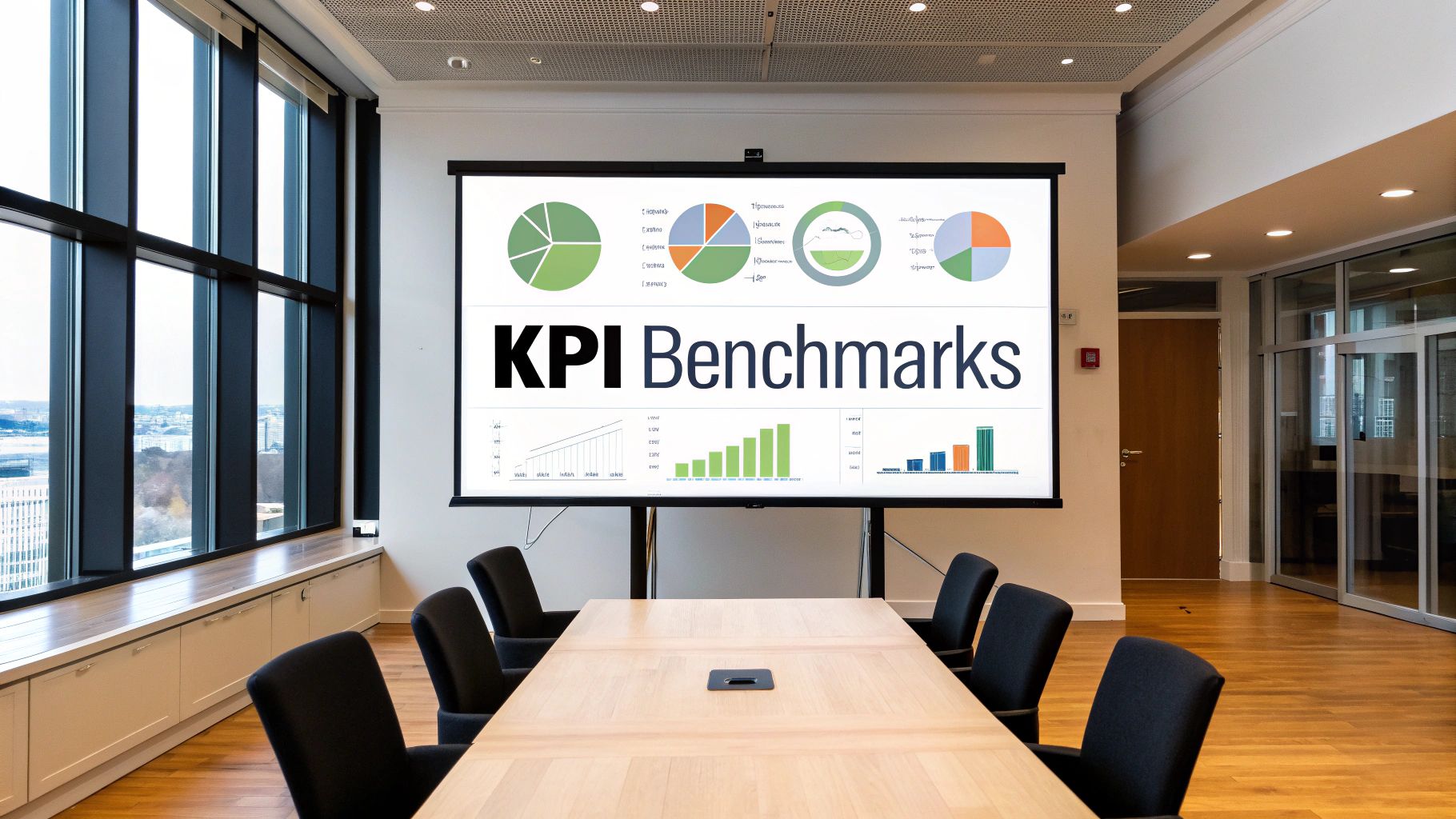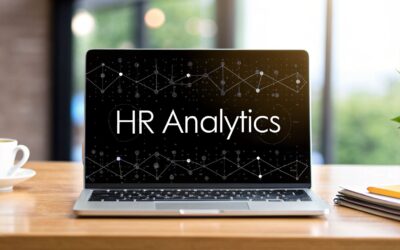Why Measuring HR Effectiveness Is No Longer Optional

The role of Human Resources has transformed. HR is no longer just about administration; it's a vital strategic driver of organizational success. This evolution demands a data-driven approach, making measuring HR effectiveness crucial for thriving organizations. This means understanding how people initiatives impact the bottom line, and demonstrating HR's value in concrete terms.
Connecting HR to Business Outcomes
Measuring HR effectiveness is vital because it links HR initiatives to tangible business results. Effective onboarding, for instance, leads to faster integration and higher productivity. Targeted learning and development programs can upskill the workforce, fostering innovation and boosting customer satisfaction. By showcasing these connections, HR builds credibility and influence within the organization.
These demonstrable links between people and profits elevate HR from a support function to a strategic partner. This new role demands a shift in how HR operates and how its success is measured.
Measuring HR effectiveness allows organizations to evaluate their impact on business success. A key metric is the employee Net Promoter Score (eNPS), which measures how likely employees are to recommend their workplace. This reflects employee satisfaction and engagement, which are critical for productivity. A high eNPS often indicates higher engagement and satisfaction, potentially leading to better retention.
Other important metrics include engagement rate and employee turnover rate. These help HR departments identify areas for improvement to boost employee satisfaction and reduce costly turnover. A large percentage of turnover costs stem from recruitment and training, highlighting the importance of tracking these metrics. Explore this further: How To Measure HR Effectiveness
Convincing Executives and Identifying Opportunities
Data-driven insights empower HR to demonstrate its strategic value to executives. Presenting clear metrics that link HR programs to key business objectives, such as revenue growth or cost reduction, solidifies HR's position as a driver of organizational performance.
Furthermore, measuring HR effectiveness reveals opportunities for improvement. Analyzing turnover data, for example, can identify departments or roles with high attrition. This enables HR to investigate the root causes and implement targeted retention strategies. This proactive approach saves resources and strengthens talent management capabilities. This data-driven approach not only justifies HR's current activities but also highlights its potential for future contributions.
Gaining a Competitive Edge
Organizations that embrace robust HR analytics gain a competitive edge. Using data to inform decisions about workforce planning, talent acquisition, and employee development allows these organizations to attract, retain, and engage top talent. This results in a more productive, innovative, and adaptable workforce, enabling them to respond effectively to market changes and outperform competitors. In today's dynamic business environment, measuring HR effectiveness is not just beneficial—it's essential for survival and sustained growth. This data-driven focus empowers HR to drive real change and contribute significantly to long-term organizational success.
The HR Metrics That Actually Move the Needle

Not all metrics are created equal. Some offer interesting insights, while others provide the crucial information needed to inspire real organizational change. This section helps you discern between vanity metrics and those that genuinely fuel HR effectiveness. We'll focus on the measurements that truly make a difference.
Focusing on Impactful Measurements
Leading companies understand that measuring HR effectiveness requires a laser focus on metrics directly tied to business outcomes. Tracking time-to-hire is useful. But it becomes truly powerful when linked to the cost of unfilled positions and its effect on productivity.
Employee satisfaction scores also gain deeper significance when correlated with customer satisfaction and retention. This vital connection demonstrates how HR initiatives directly contribute to the bottom line. It's about making a real impact.
This targeted approach ensures that all HR efforts are strategically aligned with overarching business goals. It empowers HR to prioritize initiatives with the greatest potential for positive change and showcase their value to the organization.
Key Metrics Across HR Functions
Effective HR measurement spans across all HR functions, weaving a tapestry of insights. Within recruitment, metrics like cost-per-hire, time-to-fill, and quality-of-hire provide valuable data points.
However, these should be analyzed alongside new-hire performance and retention data to gain a complete understanding. This holistic approach paints a comprehensive picture of recruitment effectiveness. For retention, employee turnover rate and employee lifetime value are essential. Analyzing these alongside exit interview data reveals the true drivers of attrition, informing targeted retention strategies and fostering a thriving work environment.
Performance management metrics should move beyond basic performance ratings, delving deeper into the nuances of individual and team contributions. Measuring goal attainment, project completion rates, and the impact of individual efforts on team success provides a much richer understanding of employee effectiveness.
Finally, engagement metrics, such as eNPS and pulse survey results, offer a window into the emotional connection employees have with their work. This data should be segmented by demographics and departments to uncover hidden trends and address specific engagement challenges, cultivating a sense of belonging and purpose.
To illustrate this further, let's examine a comparison of some core HR metrics. The following table provides a breakdown of key metrics, their calculations, and their business impact.
Let’s take a look at a detailed breakdown of crucial HR metrics. The table below outlines how to calculate them, understand their significance, and gauge their impact on business success.
| Metric | Calculation Method | What It Measures | Business Impact | Benchmark Range |
|---|---|---|---|---|
| Employee Turnover Rate | (Number of employees who left / Average number of employees) * 100 | How often employees leave the company | Impacts costs related to recruiting, hiring, and training | 10-20% |
| Time to Fill | Number of days from job posting to offer acceptance | Efficiency of the hiring process | Affects productivity and can lead to lost revenue if positions remain vacant | 30-45 days |
| Cost Per Hire | (External costs + Internal costs) / Number of hires | Cost efficiency of recruiting efforts | Helps optimize recruitment budget and resource allocation | Varies greatly by industry and role |
| eNPS (Employee Net Promoter Score) | % of Promoters – % of Detractors | Employee loyalty and likelihood to recommend the company | Influences employee retention, morale, and productivity | 10-30 considered good, 30+ excellent |
| Revenue Per Employee | Total revenue / Number of employees | Employee productivity and contribution to revenue generation | Helps assess overall business performance and identify areas for improvement | Varies greatly by industry and company size |
This table highlights just a few of the key metrics you can use to assess and enhance HR effectiveness. By understanding what these metrics reveal and how they connect to business outcomes, you can leverage them to drive meaningful change.
Benchmarks and Interpretation
Understanding how your organization compares to industry benchmarks is crucial for interpreting your HR metrics. A turnover rate of 15% might seem high, but if the industry average is 20%, it suggests your organization is performing relatively well. Benchmarks offer valuable context.
However, benchmarks are just a starting point. It's important to consider your organization's unique context, such as industry, size, and stage of growth, when evaluating metrics. A high turnover rate in a rapidly growing startup might be expected, while the same rate in a mature organization could signal a deeper issue.
This contextualized approach ensures that you're not just measuring numbers, but understanding their implications for your specific organization. This deeper understanding empowers you to make informed, data-driven decisions.
Communicating with the C-Suite
Presenting HR metrics to executives requires translating HR success into the language of finance. This involves demonstrating the return on investment (ROI) of HR initiatives and their impact on key financial indicators. Showcasing how reduced turnover leads to lower recruitment costs and increased productivity resonates powerfully.
Additionally, illustrating the connection between employee engagement and customer satisfaction or revenue growth demonstrates HR's strategic contribution. It’s about showing the value HR brings to the table.
By quantifying the financial impact of HR efforts, you can secure buy-in for strategic initiatives. This positions HR as a strategic partner, ensuring that HR's voice is heard and its contributions recognized. It's about being a vital part of the bigger picture.
Creating Your HR Measurement Framework That Delivers

Simply collecting random HR metrics isn't a magic bullet for HR improvement. To truly gauge HR effectiveness, you need a structured measurement framework tailored to your organization's unique goals. This means pinpointing the right metrics, establishing reliable data collection, and communicating insights effectively. This section offers a blueprint for building such a system.
Identifying Key Metrics for Your Business Context
The first step is determining which metrics genuinely matter to your specific business context. If your organization prioritizes rapid growth, time-to-hire and cost-per-hire become crucial.
However, if retaining top talent is paramount, metrics like employee turnover rate and employee lifetime value take center stage. For a broader perspective on relevant HR metrics, explore these HR metrics.
Also, consider your organization's strategic challenges. If innovation is a key objective, measuring employee innovation index and training effectiveness becomes vital. This focused approach ensures your HR measurement framework directly addresses your business's most pressing needs.
Furthermore, in today's competitive talent landscape, effective hiring is essential. Finding quality candidates is a challenge for 71% of companies. This underscores the importance of metrics like time-to-hire and cost-per-hire. Optimizing these processes is key for managing recruitment costs while efficiently filling vital roles. With approximately 91% of businesses actively hiring in 2024, the need for efficient recruitment is even more apparent. For further insights into these statistics, see Learn more about HR Statistics.
Establishing Reliable Data Collection Processes
After identifying your key metrics, you need reliable data collection processes. This involves using existing HR systems like BambooHR, implementing new tools where needed, and training your team on proper data entry. This ensures data accuracy and consistency.
Data collection shouldn't overburden your team or budget. Prioritize automation and streamline processes to minimize manual effort. This empowers your HR team to focus on analysis and interpretation, maximizing your data's value without creating undue burden.
Designing Effective HR Dashboards and Benchmarks
Raw data is useless without effective visualization and interpretation. Design HR dashboards that clearly communicate key insights to different stakeholders. Executive leaders need high-level summaries of HR's impact on business outcomes.
Department managers, however, require more granular data to inform their team's performance. Using tools like Tableau can help create impactful dashboards.
Finally, establish meaningful benchmarks to track progress and drive continuous improvement. These benchmarks should be both challenging and attainable, motivating your team to strive for excellence while staying grounded. This balance creates a culture of data-driven decisions and continuous development.
Beyond Basic Metrics: HR Analytics That Drive Decisions

True HR effectiveness isn't just about tracking metrics. It's about using data to make smart decisions. This means moving beyond basic descriptive analytics (what happened?) to more powerful tools like predictive analytics (what might happen?) and prescriptive analytics (what should we do?). This evolution is how we unlock the true potential of HR data.
Uncovering Hidden Patterns and Relationships
Top organizations use HR analytics to find hidden patterns in their workforce data. For example, by linking employee performance with learning and development programs, HR can pinpoint the training that has the biggest impact on productivity. This data-driven approach leads to smarter investments in training and development.
Also, connecting seemingly unrelated data can reveal surprising insights. Imagine finding a link between commute times and employee engagement. This might lead to exploring flexible work options or wellness programs for commuters. These discoveries open up new possibilities.
This deeper understanding of talent helps HR move from reacting to problems to proactively building strategies. It shifts HR from a cost center to a strategic partner driving business results.
Analytics Approaches for Different Capabilities
The methods used for HR analytics depend on an organization’s resources. Smaller organizations can begin with simple spreadsheet analysis in tools like Microsoft Excel to track key metrics and spot basic trends. This provides a solid foundation in data analysis.
As organizations grow, they can explore dedicated HR analytics platforms. These platforms offer advanced features for data visualization, predictive modeling, and reporting.
Organizations with greater resources can use AI-powered solutions to automate data analysis, uncover complex patterns, and gain predictive insights. This opens the door to a new level of HR intelligence. This flexible approach lets organizations scale their analytics capabilities to fit their specific needs.
Overcoming Common Analytics Challenges
Effective HR analytics comes with challenges. Data fragmentation, where employee information is scattered across different systems, can make analysis difficult. This requires a focus on data integration.
Also, skills gaps within HR teams can limit the ability to use data effectively. Investing in training will empower teams to use data effectively. This ensures that HR professionals have the skills to understand and use the available data. Furthermore, resistance to analytics-driven decisions can create a cultural obstacle. This calls for clear communication about the value of data and showcasing its impact with real-world examples. Trust in data is key for successful implementation.
Measuring HR effectiveness internationally adds another layer of complexity due to different workforce dynamics and regulations. Standardized metrics like cost-per-hire and time-to-fill offer a common language, while HR analytics provides deeper insights into regional trends. For a deeper dive into these global factors, explore measuring HR effectiveness internationally. Discover more insights about international HR metrics. By recognizing and addressing these challenges, organizations can build a path to successful HR analytics.
Capturing True Employee Engagement (Not Just Satisfaction)
True employee engagement signifies more than just satisfaction—it represents a deep emotional commitment to the organization and its mission. It's the driving force behind enhanced productivity, groundbreaking innovation, and exceptional customer satisfaction. Yet, many companies still rely on traditional annual surveys, which often miss the nuances and ever-changing nature of employee sentiment. It's time to embrace more insightful methods for measuring this vital connection.
Moving Beyond Annual Surveys
Traditional annual surveys offer a glimpse into employee sentiment, a snapshot frozen in time. However, they lack the continuous feedback needed to effectively nurture engagement in today’s dynamic workplace. To truly understand and address the ebb and flow of employee connection, we need more agile tools. Leading organizations are adopting pulse surveys, short, frequent bursts of inquiry that provide real-time insights into specific areas of concern.
Employee Net Promoter Score (eNPS) offers another valuable tool, a simple yet effective metric to gauge employee loyalty and their willingness to recommend the organization as a great place to work. Qualtrics is a platform many companies use for this and other important feedback initiatives. These methods empower HR to address issues swiftly and proactively.
Furthermore, integrating qualitative feedback mechanisms, such as focus groups and personal one-on-one conversations, adds depth and context to the quantitative data. These rich narratives paint a more complete picture of the employee experience, helping us understand the "why" behind the numbers. This multifaceted approach provides a holistic view of employee engagement.
Identifying Unique Engagement Drivers
What inspires and motivates employees varies significantly from one organization to the next. A one-size-fits-all approach simply won't work. It's essential to identify the unique engagement drivers within your specific organizational context. Through targeted measurement approaches, HR can pinpoint what truly resonates with their people.
Perhaps opportunities for professional growth are paramount, or maybe work-life balance and genuine recognition are more impactful. Understanding these unique motivators empowers HR to personalize engagement strategies and create a workplace where everyone thrives.
Segmenting Data and Uncovering Trends
Employee engagement isn't a monolithic entity; it fluctuates across different segments of the workforce. To accurately measure HR effectiveness, it’s crucial to segment engagement data by department, tenure, role, or demographic factors.
This segmentation process can uncover hidden trends and disparities. For example, discovering significantly lower engagement within a specific department reveals a potential area of concern requiring immediate attention. This early identification allows for proactive intervention and targeted support.
Turning Insights Into Action
Effective measurement is meaningless without action. Gathering data is just the first step. HR must then translate those findings into targeted intervention strategies. This might involve launching new programs, revising existing policies, or providing additional resources to specific teams.
Perhaps the data reveals a need for greater recognition. HR could respond by implementing a new rewards program, celebrating achievements and contributions. If work-life balance emerges as a concern, exploring flexible work arrangements or wellness initiatives could be the answer. These targeted actions demonstrate a genuine commitment to fostering a positive and supportive employee experience. Let's compare different engagement measurement tools:
To help illustrate, here's a table that compares various methods:
Employee Engagement Measurement Tools Comparison: This table compares different engagement measurement approaches, highlighting their benefits, limitations, and best implementation scenarios.
| Measurement Tool | Main Benefits | Limitations | Resource Requirements | Best Used For |
|---|---|---|---|---|
| Annual Surveys | Comprehensive overview | Infrequent, can be outdated | Moderate | Baseline measurement, broad insights |
| Pulse Surveys | Frequent, real-time feedback | Can lack depth | Low | Tracking specific issues, quick feedback |
| eNPS | Simple, easy to understand | Limited insights | Low | Measuring overall loyalty and advocacy |
| Qualitative Feedback (Focus Groups, Interviews) | Rich, contextual insights | Can be time-consuming, subjective | Moderate to high | Exploring complex issues, gaining in-depth understanding |
By leveraging this diverse toolkit of measurement strategies, organizations can gain a profound understanding of their employees' emotional connection to their work. This understanding paves the way for developing impactful strategies to bolster engagement and drive positive business outcomes.
Translating HR Success Into Financial Language
To truly earn a seat at the strategic table, HR leaders must speak the language of financial impact. This means going beyond traditional HR metrics and showcasing how people initiatives directly affect a company's bottom line. This section offers practical frameworks for linking HR data to financial outcomes that resonate with executive leadership.
Calculating the ROI of HR Initiatives
Effective HR departments understand the vital role of demonstrating the return on investment (ROI) of their programs. For instance, what's the financial return of a new leadership development program? By monitoring metrics like employee performance improvements, promotion rates, and even the influence on revenue generation, HR can quantify the program’s financial benefits.
This data-driven methodology shifts HR from a cost center to a value driver, highlighting the concrete returns of investing in people. This clear link between HR initiatives and financial gains is essential for securing executive buy-in and budget approval.
Quantifying the True Cost of Turnover
Employee turnover isn’t just an HR problem; it’s a substantial financial burden. Calculating the true cost of turnover involves considering not only the direct costs of recruitment and training but also the indirect costs like lost productivity, reduced morale, and the impact on customer relations.
By presenting a comprehensive view of turnover's financial impact, HR can emphasize the significance of retention strategies and validate investments in programs that aim to enhance employee engagement and loyalty. This effectively translates HR's impact into the language of executives – dollars and cents.
Demonstrating the Financial Impact of Engagement
Employee engagement directly correlates with a company’s financial well-being. Engaged employees are generally more productive, innovative, and committed to customer satisfaction, all of which contribute to greater profitability. HR can showcase this connection by tracking the relationship between engagement scores and key financial indicators such as revenue growth, customer retention, and even stock price.
For example, if a company experiences a 10% increase in employee engagement along with a 5% increase in revenue, it establishes a powerful link between investing in the workforce and improved financial performance. This data-driven narrative offers compelling proof of HR's strategic contribution to the organization.
Connecting People Programs to Business Results
Creating clear connections between HR programs and business outcomes demands a systematic approach. This involves pinpointing the specific business goals the HR initiative aims to support, defining the metrics that will gauge its success, and diligently tracking the data.
For instance, if the objective is to elevate customer satisfaction, HR might implement a training program focused on customer service skills. By tracking metrics such as customer satisfaction scores, customer retention rates, and the financial effect of repeat business, HR can directly tie the training program to enhanced business results. This visible connection between people and profits reinforces HR's role as a strategic driver.
Building Compelling Financial Narratives
Data alone isn't always persuasive. HR professionals need to develop compelling financial narratives around their data. This involves presenting clear, concise, and visually appealing reports that underscore the key takeaways and connect them to business objectives.
Using visual aids like charts, graphs, and case studies can strengthen the narrative by illustrating the impact of HR initiatives in a relatable and easily understandable way. This method transforms raw data into impactful stories that resonate with executive leadership and ensure buy-in for future HR investments.
Ready to empower your HR department to become a strategic force? The Global Human Resource Institute offers a variety of certifications, including HRQP, HRAP, and HRCE, designed to provide you with the skills and expertise necessary to measure HR effectiveness and communicate your success in financial terms. Visit their website to learn more and advance your HR career.




0 Comments